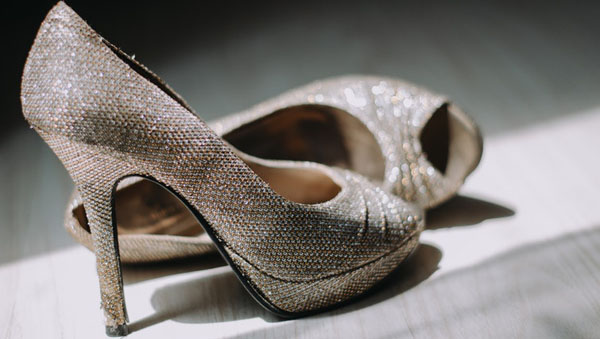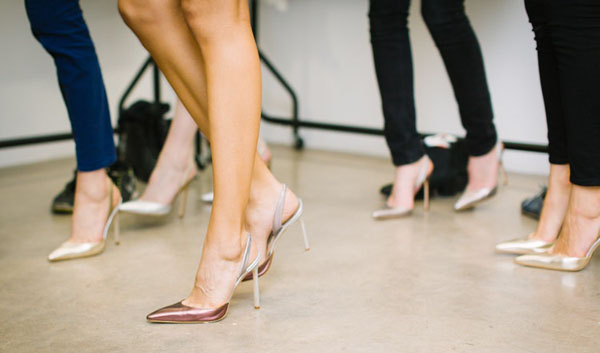By Yvonne Sam
Social and Political Commentator
 Let’s get it right, from the start and coming straight from the heart: I do not hate high heels, but instead abhor the idea that they are seen as indicators of female elegance when, in my experience, the vast majority of females find them extremely painful and hobbling.
Let’s get it right, from the start and coming straight from the heart: I do not hate high heels, but instead abhor the idea that they are seen as indicators of female elegance when, in my experience, the vast majority of females find them extremely painful and hobbling.
Learning to walk in heels is a rite of passage for many women and can be an untrustworthy road, paved with broken heels, sore feet, and unexpected tumbles. And on first learning to walk in heels, you tend to look like a baby giraffe taking its first steps.
Another disturbing point is that heels have been touted to make a woman’s feet look smaller, as if there was not enough criticism about their bodies, that they had to also include foot size.
Stiletto heels is analogous to the disturbing practice of Chinese foot binding, which was the custom of applying tight binding to the feet of young girls, in order to alter the shape and size of their feet. Feet altered by binding were called lotus feet and were considered a status symbol, as well as a mark of beauty. The practice began in China as early as the 10th century, during the Song dynasty, and only truly ended in 1949, with the creation of the People’s Republic of China.
According to fashion experts, “wearing heels makes a woman feel in charge, because height is the converse of power. She always wants to be taller than her opponent, and wearing heels make her look down at someone, instead of looking up at someone”.
The whole idea of wearing heels in order to “feel taller” is way beyond my reasoning. If that’s the accepted logic, then short men should be suffering in stilettos instead of relatively comfortable platform shoes — that is if they care at all about their height.
High heel shoes are shoes that have a high heel that comes in many different shapes, and tend to give the aesthetic illusion of longer, more slender legs. These heels may range from less than 2.5 inches or as much as over 6 inches in height. Questions asked about high heels have ranged from the sublime to the ridiculous.
The following question was posed in 2014 by serial entrepreneur, Antonia Dunbar: “Is the high heel a tool of empowerment or a tool of the patriarchy, designed to slow a woman down”? She believes that in the modern professional context, many women continue to wear the heel because it makes them feel empowered.
“There are many feminists that love to wear their heels,” says Dunbar. “If you look at a snapshot of the most successful women in America and around the world — Oprah Winfrey, J.K. Rowling and Tina Fey of Saturday Night Live fame — they wear these towering, teetering heels.
Shower all the praise you want on high heels — provocative, sexy, and beautiful and more — for even their most devoted fans would concur that they are nevertheless impractical. They are useless for driving or hiking, and women wearing heels are advised to stay off of the grass, and also ice and highly polished floors.
Additionally, high heels do not tend to be very comfortable; it is almost as if they were not designed to walk in. Yes, it is really sad to see the amount of females, who claim they care about themselves, only really care about following the dictates from a fashion industry.
Beauty is in no way about being a slave to ridiculous fashions. And in an oxymoronic twist, if you do not even care to treat your feet with respect then it is somewhat difficult to believe that you care about yourself.
Lately, high heels have come under significant controversy, with many podiatrists seeing patients, whose severe foot problems have been caused, almost exclusively, by high-heel wear. Trudging around in most types of heels, especially stilettos, is a sure recipe for blisters, swollen toes, throbbing heels, a general sense of misery, and even long-term health issues, like nerve damage.
Ask any woman — who has gone through an evening standing, walking, dancing or merely leaning, casually, against a bar in high heels — about the pulsing, constrictive, numbing pain those heels can cause.
What do you think accounts for the many high heel shoes that lay unceremoniously unattended under the pews in church, especially on Sundays, beneath the table at parties/functions etc. or tossed in any old corner– visible evidence of full alienation from its owner? And yet, it’s a common part of women’s lives as 73 percent of women wear them, for to some, heels are a nasty habit almost like an addiction.
According to a study, conducted by the American Orthopaedic Foot and Ankle Society, 50 percent of women experience daily pain from their shoes. Heels put pressure on the spine, back, knees, and toes, which can lead to painful conditions like sciatica. www.ncbi.nlm.nih.gov/pubmed/8454237. But women still wear them. Why?
Women need the non-negotiable right to wear flats if they so desire, and the equally inalienable right, of course, to wear heels if they wish to. However, on a cautionary note, what all women should bear in mind, is that heels wear us, in every possible way.
Strange but nonetheless true, is the fact that heels, pretty much throughout their history, have been designed by men. With this fact in mind, men being the ones who will see the shoes but not wear them, tend to design heels with a focus on their aesthetics rather than their ergonomics.
While signifying glamour and femininity for generations, a pair of high heels was once an essential male accessory. French designers, Roger Vivier and Andre Perugia, invented the stiletto in the early 1900’s.
The shoes were soon popularized by screen actresses, Marilyn Munroe and Rita Hayworth, and soon became an integral part of the modern woman’s wardrobe. Additionally and somewhat unashamedly, women have a long history of fashion. A craze in women’s fashion, for adopting elements of men’s dress, meant their use soon spread to women and children.
To quote Will Smith in his generative film, Men in Black, “[We] make this sh*t look good.” Whether it is denim or suiting, women have refused to let any area of fashion remain a boys-only club. And by far, women’s greatest conquest was the high heel.
Revisiting the Heel
There’s evidence that butchers, in Ancient Egypt, wore heels to avoid soaking their feet in blood. In Rome, where the sex trade was legal, high heels helped clients identify prostitutes in crowds. globalnews.ca/news/1714365/french-study-reveals-the-power-of-high-heels/.
Despite portrayals of heels, dating back to ancient Egypt, they really became popular in 15th century Persia, where they were worn by male equestrians. According to Elizabeth Semmelhack, a curator from the Bata Shoe Museum in Toronto, Canada, home to the world’s exhaustive collection of shoes and footwear artifacts: “When the soldier stood up in his stirrups, the heel helped to secure his stance so that he could shoot his bow and arrow more easily.” Heels were intended to be an instrument of war, rather than one of seduction.
In time, messengers from Persia began travelling to Europe and brought with them their heels, where male European aristocrats took note. For them, the extra height designated power and nobility, and the relative impracticality signified a labor-free lifestyle.
In the 16th century, Italian courtesans bridged the gender gap and adopted heels as a symbol of irreverent and androgynous sexuality. People, who reference Henry VIII, often talk about how godly he appeared, as he stood 6’2″ in the 1500s. It was the desire of men to look taller and in consequence more intimidating; high heels were not supposed to be pretty, they were supposed to be kind of scary.
In the 1630s women began cutting their hair and adding epaulettes (shoulder pads) to their outfits. They would also smoke pipes, and wear hats that were very masculine. And this is why women adopted the heel — it was in an effort to masculinize their outfits.
From that time, Europe’s upper classes followed a unisex shoe fashion until the end of the 17th Century, when things began to change again. Men started to have a squarer, more robust, lower, stacked heel, while women’s heels became more slender, more curvaceous.
As the wearing of heels filtered into the lower ranks of society, the aristocracy responded by dramatically increasing the height of their shoes — and the high heel was born. By 1740 men had stopped wearing them altogether.
Conclusively, it is apparent that heels are both a claim of femininity and a test of it. In their teetering heights, they make bold suppositions about fashion and feminism, and professionalism, sex and power. Females choose, day by day, week by week, and special occasion by special occasion, to let them do it.
Separated from their symbolism, heels are simply shoes that help to separate the human foot, which is conveniently soft, from the surface of the earth, which is inconveniently hard. Heels at once lift women up and hold them — hold us — back. They are the bindings of the willfully bound.
It is utterly senseless favoring footwear which harms and hurt feet, plus renders it difficult to run from predators. Different brands of shoes create a different walking experience.
On a happy note, while some females are still reeling from the heeling, there are shoe designers trying to improve the design of the current heel, so that when you walk you will not feel pain.
So if history has a say, fashion will come and fashion will go. From the wearing of heels some females will have a lot of scars to show, simply because advice was dismissed in the quest to appear feminine and stylish.
Yvonne Sam, a retired Head Nurse and Secondary School Teacher, is Vice-president of the Guyana Cultural Association of Montreal. A regular columnist for over two decades with the Montreal Community Contact, her insightful and incursive articles on topics ranging from politics, human rights and immigration, to education and parenting have also appeared in the Huffington Post, Montreal Gazette, XPressbogg and Guyanese OnLine. She is also the recipient of the Governor General of Canada Caring Canadian Citizen Award.
 Pride News Canada's Leader In African Canadian & Caribbean News, Views & Lifestyle
Pride News Canada's Leader In African Canadian & Caribbean News, Views & Lifestyle








